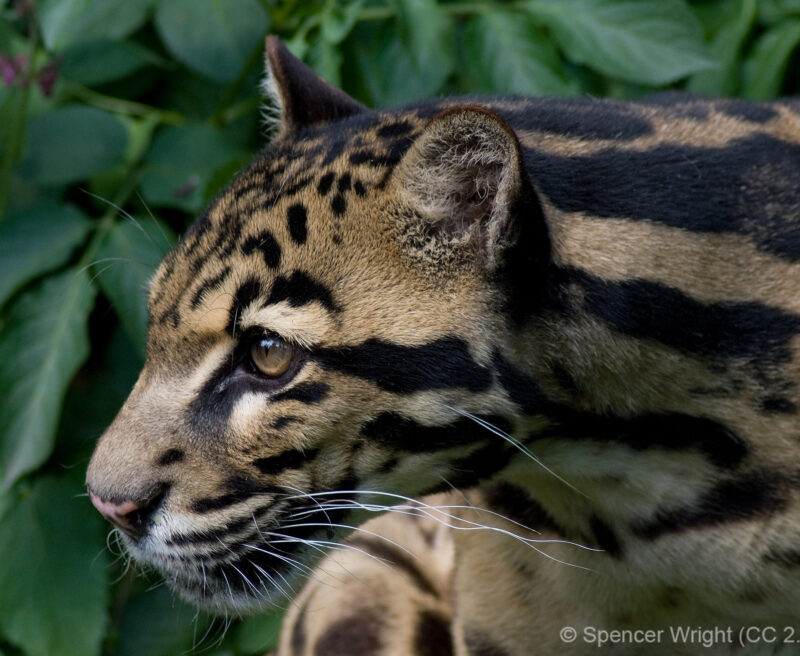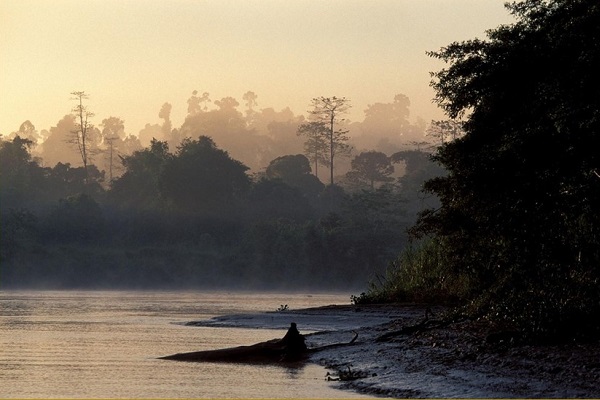Sunda Clouded Leopard
Species Data
Class: Mammalia
Order: Carnivora
Family: Felidae
Scientific Name: Neofelis diardi
IUCN Red List status:Vulnerable
Description
The identification of Sunda Clouded Leopard as a genetically separate species from mainland Asia’s Clouded Leopard (Neofelis nebulosa) took place 15 years ago, amid findings that both species had been separated 1.4- 2.9 million years ago.
Like their mainland counterparts, the Sunda Clouded Leopard takes its name from the large, blotchy, ‘cloud-like’ markings. This particular species native to Borneo and Sumatra is generally darker and boasts smaller markings, each featuring a defined border enclosing smaller spots. Its cheeks and neck are marked with black bars, with canines that are longer in relation to their skull size than with any other felid species.
Everything in the long, slim body of a Sunda Clouded Leopard is built for tree-climbing: the ring-marked, black-tipped tail that can reach one metre in length helps with balance, while the broad paws and hind legs – noticeably longer than its stocky front ones – make this species a highly effective climber of tree canopies.
Behaviour
There are still a great many unknowns about the Sunda Clouded Leopard’s behaviour due to their highly secretive and nocturnal nature. Extensive camera trap studies are ongoing around the world to help build a body of knowledge that allows to better protect this species from being uplisted to Endangered and worse.
What is known so far indicates that these felids can breed all year round, producing litters of one to five cubs after a gestation period of 85-95 days. The cubs wean off their mother at 10 months of age and become reproductive when they reach two years old.
To sneak up on their prey – which ranges from monkey to macaques, deer, pigs, porcupines, fish and civets – the Sunda Clouded Leopard utilises its formidable climbing capabilities. Their flexible hind joints enable them to climb headfirst down vertical tree trunks and to even hang from branches as they grab hold of prey, boosting their grip by wrapping their long tails around the tree boughs.
Habitat
The Sunda Clouded Leopard appears to be forest-dependent within the islands of Borneo and Sumatra. Within Borneo, this species occurs in lowland rainforest, below 1,500m of elevation, and densities have been estimated at between six to nine cats per 100km2. It is also thought to occur within the protected areas of Sabah, Malaysia.
Meanwhile, in Sumatra these tree-climbers are more abundant within hilly, montane areas but occur in much lower densities, possibly due to the competition with the Tiger (Panthera tigris) they share habitat with.
Threats and Conservation
The largest threat to the Sunda Clouded Leopard is habitat loss. Both Sumatra and Borneo have high deforestation rates due to palm oil plantations, clearance for settlements and agriculture, which reduces both the species’ habitat range as well as the availability of the prey it relies on to survive. Within Sumatra or Borneo, there are currently no protected areas large enough to ensure a sustainable viable population.
Another increasing, and interlinked threat is the illegal trade, with the leopard’s skin and body parts having high commercial value within the Asian medicine industry. With less habitat for the Sunda Clouded Leopard to inhabit, poaching becomes easier and risks exacerbating the population decline already brought about by habitat loss.
The biggest constraint for Sunda Clouded Leopard conservation efforts is the lack of knowledge that surrounds the species, making it crucial to safeguard its habitat. For years now and continuing with two new purchases to expand the Pangi corridor in 2021, donations from WLT supporters have been helping partner Hutan to protect the rainforests of the Kinabatangan Floodplain, a confirmed home for the Sunda Clouded Leopard.


